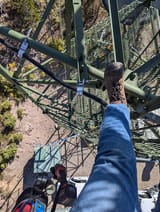Search Results
4/26/2025, 11:03:56 PM
>>2815949
>It's an interesting question. A work environment is different because 1) you don't get to choose your own amount of risk and 2) the company has some liability if something goes wrong. Because of this you're going to have much stricter safety protocols.
so about that, I am my company so I have a lot more say about the jobs I take or don't.
I have a hard policy of "No rank when it comes to safety" - anyone can, and has the responsibility to, call that "Stop" if the situation changes and something's not being done safely. A lot of ops I work with take a similar approach, so it's not like boss man saying "Go do this" and you don't have a choice, there's a definite risk-management and risk-acceptance level that's discussed and the climb/job is aborted if things don't jive.
>When climbing on rock, the most important safety decision you can make is "should I climb this route today?"--trying to match your abilities against that particular climb. If you climb within your comfort zone then it is very unlikely anybody will get hurt. On a job, you don't get to make that choice.
Absolutely do have that choice. "Personnel working within skill set" is a big deal. The site's still going to be broken tomorrow, the day after, the day after that. And complacency kills climbers.
>Ideally, both partners have a good grasp on self-rescue techniques, wilderness first aid, and know exactly what they will do in an emergency. In reality most people are just hoping for the best.
"Tower Competent" credential is that self-rescue, hurt-man rescue card. FA/CPR is nearly universal in the industry, outside of the wild-west crews that dgaf about their guys.
ISO 31000 Risk Management guidelines is where a lot of the industrial stuff comes from, and many of the rec training programs (AIARE in particular) takes a lot from that framework as well. TASARM from the Canadian snow/avalanche world also shares a lot. Both are very exciting books, if you can't sleep at night.
>It's an interesting question. A work environment is different because 1) you don't get to choose your own amount of risk and 2) the company has some liability if something goes wrong. Because of this you're going to have much stricter safety protocols.
so about that, I am my company so I have a lot more say about the jobs I take or don't.
I have a hard policy of "No rank when it comes to safety" - anyone can, and has the responsibility to, call that "Stop" if the situation changes and something's not being done safely. A lot of ops I work with take a similar approach, so it's not like boss man saying "Go do this" and you don't have a choice, there's a definite risk-management and risk-acceptance level that's discussed and the climb/job is aborted if things don't jive.
>When climbing on rock, the most important safety decision you can make is "should I climb this route today?"--trying to match your abilities against that particular climb. If you climb within your comfort zone then it is very unlikely anybody will get hurt. On a job, you don't get to make that choice.
Absolutely do have that choice. "Personnel working within skill set" is a big deal. The site's still going to be broken tomorrow, the day after, the day after that. And complacency kills climbers.
>Ideally, both partners have a good grasp on self-rescue techniques, wilderness first aid, and know exactly what they will do in an emergency. In reality most people are just hoping for the best.
"Tower Competent" credential is that self-rescue, hurt-man rescue card. FA/CPR is nearly universal in the industry, outside of the wild-west crews that dgaf about their guys.
ISO 31000 Risk Management guidelines is where a lot of the industrial stuff comes from, and many of the rec training programs (AIARE in particular) takes a lot from that framework as well. TASARM from the Canadian snow/avalanche world also shares a lot. Both are very exciting books, if you can't sleep at night.
Page 1
